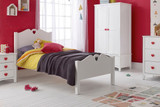Do you need a hypoallergenic mattress on a child’s bed?

Many children today suffer from allergies, and numbers are on the rise. However, the symptoms can often be effectively managed by minimising a child’s exposure to common allergens. We look at what causes night time allergies, and how a hypoallergenic mattress can help to provide a healthy and comfortable night’s sleep for your child.
Getting a good night’s sleep is essential for children. As well as helping to support their general physical health and development, it’s also important for their mental well-being (and yours too!)
Choosing the right mattress plays an important role in this, especially when you think about how much time they will spend using it – depending on their age, your child is likely to need an average of around 10-12 hours of sleep every night. But do you need a hypoallergenic mattress on a child’s bed?
If your child suffers from asthma, allergies or sensitive skin, you can help to create a more healthy sleeping environment for them by choosing a mattress that’s resistant to allergens. Synthetic materials in hypoallergenic mattresses are often the best choice as they provide an environment that’s hostile to bacteria, mould and mildew, and dust mites.
What causes children’s night time allergies?
During the night our bodies naturally lose heat and moisture, as well as dead skin cells. This creates ideal conditions for bacteria, mould and mildew, and dust mites (or more accurately, the droppings of dust mites) – tiny microscopic bugs that live in mattresses, bedding and household fabrics, and thrive in the warm, humid environment.
In fact, dust mites are one of the most common triggers for asthma, eczema and allergic rhinitis, which can cause your child to suffer from sneezing, itching, watery eyes, a runny or stuffy nose, and coughing or wheezing at night, as well as headaches and fatigue.
What kind of mattress is best for a child with allergies?

For children with asthma and sensitive skin, the synthetic materials in hypoallergenic mattresses are specifically designed to deter mites and other allergens. Our hypoallergenic single mattress is micro-quilted for extra comfort and is specially treated to help keep dust mites and allergens at bay.
Hypoallergenic single mattress. Shop here.
Memory foam and memory foam topped mattresses also have excellent hypoallergenic properties. While some standard mattresses with a coil or spring cavity can trap skin cells and dust mite droppings in the space, memory foam has a single flat surface and is more resistant to dust mites.
It also has the added bonus of moulding to your little one’s shape as they sleep, giving that extra feeling of security and comfort.
Can mattress protectors help with allergies?
Another way of helping to protect against allergens is by using a hypoallergenic mattress protector.
When you think of a mattress protector, you may remember the days of those uncomfortably hot, sticky and embarrassingly rustly plastic covers. However, these days thankfully things have moved on!
At The Children’s Furniture Company, we have a range of discreet anti-allergy fitted mattress protectors for single beds and cots: Protect-A-Bed mattress covers, which have a cool and comfortable terry towelling top; and Hippychick, which are available in pure brushed cotton or Tencel and come in a choice of colours. Tencel is a naturally hygienic fibre made from 100% biodegradable wood pulp cellulose, which offers a comfy surface for your little one to sleep on, while a polyurethane layer protects against mould, bacteria and allergens such as dust mites and pet dander – as well as protecting against any little accidents!
You can also up the ante against those pesky dust mites and other allergens by using a duvet protector. Our high quality jersey duvet protectors are breathable, lightweight and soft to the touch.
What else can I do to help protect my child against allergens?
As well as choosing an anti-allergenic mattress and using quality protective covers, you can help to reduce your child’s exposure to allergens by following these top tips:
- wash your child’s bedding regularly
- dust using a damp cloth, to avoid stirring up dust and allergens
- use a vacuum with a HEPA filter, to help trap allergens
- keep the room as tidy as possible (easier said than done, we know!)
- limit the number of stuffed animals in your child’s bed (ditto)
- make sure your child’s stuffed animals are washable
- bare floors are preferable to carpets, which can harbour allergens
- use a dehumidifier to keep excess moisture at bay
- choose synthetic bedding, rather than natural materials such as feathers
You can find out more about choosing a mattress in our Complete guide to children’s mattresses. And for more on how to help your child get a proper night’s sleep, read our guide to Children’s bedrooms and the science of sleep.
Sweet dreams!

At The Children’s Furniture Company we believe that kids’ furniture should be practical and durable, but with a sprinkle of magic. View our range of children’s mattresses here.
Recent Posts
-
Our Top 5 White Single Beds for Kids
One of the most popular types of childrens single bed is a classic white single bed. Offerin
-
Why Magical Mid Sleeper Beds are a Kid's Dream
When it comes to creating a bedroom for your child, you want it to be a place that inspires their im







